Have you ever thought of an exciting new business idea… only to look online and discover 12 other people have already done it? D’oh!
It’s no secret the business world is getting more competitive each year. The authors of Blue Ocean Strategy say there are 3 reasons for this trend:
- Technology. Improved technology allows companies to streamline their research, design and manufacturing. This means big companies can quickly release more and more products into the market.
- Globalization. 50 years ago most companies needed to compete with other local or domestic companies. Today we are often competing against the whole world. This leads to a few large winners like Amazon.
- Commoditization. As an industry matures, competing products become more and more similar to each other. This causes customers to shop based on price and dramatically shrinks profit margins. For example, when the iPhone was first released, it was a brand new concept with no direct competition. Yet today the smartphone market is crammed with options, from $100 budget phones to $1000 premium devices.
So what’s the solution to these modern problems? Most business strategy tries to help us compete harder, but the authors of Blue Ocean Strategy say that is not the answer. Instead, we need to escape the red ocean of bloody competition altogether… by sailing towards pristine blue oceans of open market space.
By following Blue Ocean Strategy, we can break established market boundaries to create breakthrough products like the Ford Model T, Nintendo Wii or Apple iTunes.
Who are the authors?
When they met 20 years ago, W. Chan Kim was a professor and Renée Mauborgne was a student. They’ve worked together ever since. Many of their articles have been published in the Harvard Business Review, Wall Street Journal and academic business journals. Today they are both professors at INSEAD, a top MBA business school.
In 2004, they wrote Blue Ocean Strategy together and it became a worldwide phenomenon. It has sold over 4 million copies and has been translated into 46 languages. It is considered a must-read book by many top executives and MBA programs.
So now let’s jump into the greatest lessons from Blue Ocean Strategy! (And I promise to do my best to make lessons about business strategy fun and easy to read about.)
1. Red Oceans: Avoid Traditional Business Competition
For a long time, most business strategy was based on military strategy. It was built on the flawed assumption that the market is a static battleground where opposing sides must fight to win territory or market share.
The dominant thought leader in business strategy was the Harvard Professor Michael Porter (Harvard Business Review). He taught for example that companies could secure a strong position in their industry through a low-cost strategy or a niche differentiation strategy. For example, if you opened a coffee shop, you could either offer the cheapest coffee or some specialty product/service like organic lattes.
The authors of Blue Ocean Strategy say that old-style business strategy keeps companies trapped in “red oceans.” Red oceans are all the established industries that exist today. They tend to be crowded markets full of cut-throat competition. It’s very hard to succeed by competing directly in a red ocean:
- Offering a better or higher quality product is usually not enough to beat an established leader in a market. For example, Pepsi consistently beats Coke in blind taste test studies, but after decades they continue to have only a fraction of Coke’s market share.
- Trying to be the lowest cost provider of a product eventually shrinks your profit margins down to almost nothing. This is why most markets only have room for one big low-cost player. In the market of discount retail stores, Walmart succeeded, but dozens of others went out of business like K-Mart and a whole industry of “variety” stores (Wiki).
- Being a differentiated niche player is also a dead end strategy, because targeting smaller and smaller market segments only leads us down a path of shrinking opportunity. It’s like cutting one pie slice into smaller and smaller slices… you can’t do that forever. On the other hand, Blue Ocean Strategy helps us find breakthrough strategic moves that expand the size of the market itself.
Up until recently, most business strategy was based on military strategy. It assumed companies must fight competitors to win territory or market share. Unfortunately, this approach keeps us stuck in “red oceans,” which are crowded and low-profit markets.
2. Blue Oceans: Find Open Market Space
Fortunately, we don’t need to remain stuck in red oceans. We can avoid the competition entirely, by finding a Blue Ocean. A Blue Ocean is an open space in the market that has yet to be explored by any other company, because it is outside of the traditional industry boundaries. The rest of this book is all about how to find or create these blue oceans.
Blue oceans, in contrast, are defined by untapped market space, demand creation, and the opportunity for highly profitable growth. (…) In blue oceans, competition is irrelevant because the rules of the game are waiting to be set.
As an example, the authors examine the circus industry. For many decades, large circus companies like Barnum & Bailey were very popular, especially among children. Generally the circus companies competed with each other by offering more animals, more simultaneous shows, or semi-famous performers. However, despite their efforts the circus industry as a whole was sinking.
Then a Canadian man created Cirque du Soleil which became incredibly successful. They became larger than the old circuses, playing shows in hundreds of cities and performing for hundreds of millions of people. Cirque du Soleil offered a new type of show that did not compete directly in the old circus industry or the theatre industry, but was something new and different. In short, they succeeded by breaking the traditional market boundaries of the circus, thereby creating a blue ocean.
Cirque du Soleil:
- Kept certain factors of traditional circuses like the tent and costumes.
- Removed factors people expected to see in a circus like the animals and famous performers.
- Added new factors to the show from other industries like theatre and dance.
- Raised the prices to be comparable to a theatre show rather than a circus.
Cirque du Soleil was the first company to offer a show of their unique style, which will make it very difficult for any new competitor to beat them. The famous marketing consultants Al Ries and Jack Trout often emphasize the importance of being first to do something new in business.
They wrote, “The basic issue in marketing is creating a category you can be first in. It’s the law of leadership: It’s better to be first than it is to be better. It’s much easier to get into the mind first than to try to convince someone you have a better product than the one that did get there first.” Learn more about marketing strategy in our summary of their book The 22 Immutable Laws of Marketing.
A Blue Ocean is an open and unexplored market space. It is an area free of competition because we need to break traditional industry boundaries to reach it. Cirque du Soleil became more successful than any previous circus company because they integrated factors of theatre into their show, thereby creating a Blue Ocean.
3. Strategy Canvas: Visualize your old and new business strategies
The first part of making a new business strategy is to map your current strategy on a visual canvas. By making our strategy visual, we will be able to more easily spot opportunities. (And don’t worry, this is a lot less complicated than it probably sounds.)
The authors call this making a “strategy canvas”:
- Make a list of all the important factors that exist in your industry (like price, speed, status appeal, etc.)
- Rate how well your product fulfills each of these factors. Then Rate how well your major competitors fulfill these factors.
- Map your ratings on a visual chart. (see below) The authors create a chart with each factor listed at the bottom on the horizontal axis. The vertical axis represents how well you rate your product fulfills each factor. Then you can draw a horizontal line through your ratings to make a “value curve” for your product.
- Check how your value curve compares to your major competitors. If they are mostly similar, then you are stuck in a red ocean. Blue Ocean companies always have a value curve that clearly diverges from competitors and they often offer factors that none of their direct competitors offer.
Let’s make this easier to understand with a real-world example. In the smartphone market, the important factors could be price, camera quality, ease of use, warranty, waterproofing, etc. An iPhone would probably rate highly in most of the important factors, but at a higher price. A $200 smartphone may rate lower on many factors, but it will appeal to price-conscious buyers. Here is what this looks like when mapped onto a “strategy canvas” with two resulting “value curves”:
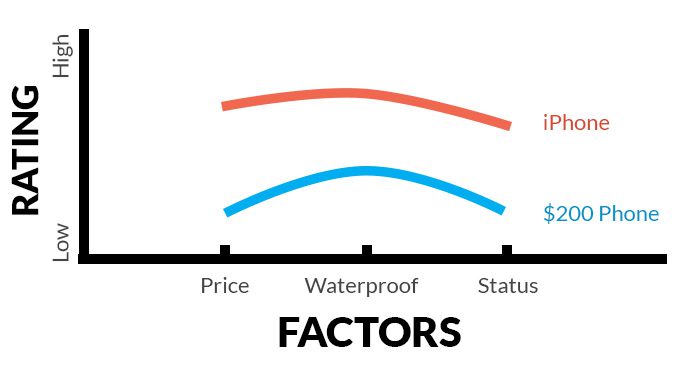
In the smartphone industry there are two main value curves: there are high-end “flagship” phones which are expensive, then there are budget phones that sacrifice some features. When the original iPhone was released, it offered a combination of factors that could not be found on other phones, like a large touch screen. Yet today the market has shifted from blue to red because most smartphones now offer similar features, which makes it difficult for a company to continue charging premium prices.
So to escape the red ocean, one of the smartphone companies must find a value curve that diverges sharply from all competitors. That is why innovative companies are always experimenting with new technologies, to offer something new that others don’t. In the case of smartphones, right now Samsung is trying to make foldable displays a mainstream feature. This could allow our phones to unfold into a large tablet. It would be like having two devices in one. It is a new factor that most other companies simply cannot offer. We’ll see if this innovation takes off in the future.
A Strategy Canvas is a tool to help us visualize our old and new business strategies. First you make a list of all important factors in your industry, then rate how well you and your major competitors fulfill these factors. Then plot your ratings on a chart to make a “value curve.” You will find a Blue Ocean when your value curve is very different from all competitors.
4. Value Innovation: Aim for Differentiation AND Low Cost
The core idea in Blue Ocean Strategy is that companies can discover a Blue Ocean of untapped market demand… by offering a combination of product factors that are significantly different than all competitors. The authors of this book calls this process Value Innovation.
We call it value innovation because instead of focusing on beating the competition, you focus on making the competition irrelevant by creating a leap in value for buyers and your company, thereby opening up new and uncontested market space.
To create a new and innovative business strategy, you must start with the product factors that you have. Then you must ask yourself:
- Which factors should I eliminate?
- Which factors should I reduce?
- Which factors should I increase?
- Which new factors should I introduce?
Notice that eliminating and reducing some factors is just as important as offering more. This is about lowering costs through offering less of what customers don’t really want anyway. Remember how Cirque du Soleil didn’t just add more to the old circus model. They also removed factors that were thought to be essential, like the animals. Removing the costs associated with animals then allowed them to add more new factors. This is a key point that makes blue ocean strategy unique:
Those that seek to create blue oceans pursue differentiation and low cost simultaneously.
As another example, the authors talk about Ford’s Model T (Driving.ca). You see, the earliest automobiles were expensive, unreliable, and basically status symbols. Then Ford came along with his Model T and changed everything. Why was the Model T the first car to become a mainstream success? Because Ford designed it to compete not against other cars, but against the dominant mode of transportation at the time: horse-drawn carriages.
The Model T sacrificed the factors of style and status appeal, but it cost a fraction of what others cars cost at the time. It was a barebones machine that came in one model and one color. Rather than being hand-built one at a time like other cars at the time, Model T’s were built on a mass assembly lines to keep costs as low as possible.
Value Innovation is about offering a unique combination of product factors. You must ask which product factors you need to eliminate, reduce, increase or introduce? Eliminating the costs of certain product factors gives us the budget to offer other new product features.
5. Find New Factors: Look Outside Accepted Industry Boundaries
Now, how do we know which factors we should increase or introduce? It’s probably not where you think…
As we said in the beginning, many companies follow traditional business strategy advice which makes them too fixated on what their competitors are doing. Other companies believe that customers have the answers, so they pour resources into surveys and focus groups. Unfortunately, neither competitors nor customers can point the way to a new blue ocean.
Rather, to find a blue ocean we must look into alternative products and non-customers. By looking outside the industry boundaries that are currently accepted, we can find new ideas and innovations. That is where we will find valuable new product factors to introduce. The authors Kim and Mauborgne say there are 6 different paths we should look into which they label “The 6 Paths Framework”:
- Research alternative products. Every business competes with a range of alternatives that are not strictly in the same industry. Your product satisfies a certain need or desire, right? Well, think of all the alternative ways your customers could satisfy that need.
For example, when we’re hungry for fast food, then we may decide to eat hamburgers, pizza or fried chicken. Yet the hamburger store owner may only view other hamburger stores as the competition, when in reality great new ideas can be found by looking at alternative products.
Another example, Southwest Airlines became successful because they knew they were competing not just with other airlines, but with other modes of transportation like trains and cars. So they priced their tickets against the price of driving a car to another city. - Research other segments in your industry. Sometimes a blue ocean can be created though borrowing certain factors from another industry segment.
For example, in the luxury segment of the car industry, Mercedes-Benz, Lexus and BMW compete against each other. The budget car makers should be looking at the luxury segment for any factors they could introduce into their own product. (Like faster service, a better warranty, premium car features, etc.) Remember to look at other segments in your industry. - Target either the buyer or the user. In many industries (especially in B2B), the person who buys the product is not the person who uses it. Switch your focus to whichever one of these people is currently neglected by the industry. This can often bring valuable ideas.
For example, traditional insulin companies had always focused on the doctors who prescribed the medication. The doctors were primarily concerned with the purity of the insulin. Then a company named Novo Nordisk switched focus to the needs and frustrations of the insulin users themselves. They created an insulin pen that made taking the medicine much easier and more convenient, and this product became incredibly successful. It all came from switching focus from the buyer to the user - Research complementary products. When someone is using your product, what other products do they use with it, perhaps before or after? For example, an e-commerce store that sells baby diapers could also offer baby clothes or baby food. These are all complementary products.
- Switch to a functional or emotional appeal. Some industries are very functional and utilitarian, while others play to emotions. Try doing the opposite of what others in your industry do.
For example, the investment industry was traditionally based on emotional appeal, it was built around the personal relationship you had with your financial adviser or stock broker. Then the industry was revolutionized by new products that were purely functional. Vanguard became a large player through offering mostly automated, low-cost index funds. On the other hand, Richard Branson uses his Virgin brand to infuse emotions into industries that are mostly functional, like airlines. - Forecast Trends. Keep an eye out for which long-term trends may affect your industry. In the case of Cirque du Soleil, the founder saw that moral attitudes around animal treatment were changing, which allowed him to remove animals from the show and sell that as a benefit.
The richest man in the world, Jeff Bezos said “Never chase the hot thing… you need to position yourself and wait for the wave.” In his career, Bezos has constantly jumped on new trends before his competitors. First, he launched Amazon as one of the first e-commerce stores, when most people believed the internet would not be important. They also pioneered many new website features like customer reviews and dynamic product recommendations.
But many years later, the Amazon team was shocked when Apple’s iTunes store destroyed the sales of Amazon’s music CD business. Bezos took that failure as a lesson: Amazon must always try to put itself out of business by launching new products even if they disrupted their current business, otherwise the competitors would.
A few years later, they launched the Kindle ebook reader. Bezos was obsessed with making the device easy to use like an Apple product. You have to understand the Kindle could have potentially destroyed Amazon’s main business of selling paper books. However, they took a big risk and it paid off. You can hear more behind-the-scenes Amazon stories in our summary of The Everything Store.
Find new factors to introduce into your own product by researching: alternative products, other industry segments and complementary products. You can also switch your strategy to either functional or emotional appeal, or target the users or buyers of the product. Finally, pay close attention to long term trends.
6. Fair Process: How to Introduce a New Strategy
Unfortunately, sometimes a new business strategy may provoke resistance within a large organization. When employees do not feel involved and included in the creation of the new strategy, then they may feel the new changes are a threat to their future. In one example mentioned in the book, a lack of communication between management and employees resulted in the very slow adoption of a new strategy at a factory and possibly even internal sabotage.
Fair process is how we can smoothly introduce a new business strategy; it has 3 steps:
- Engagement. Ask everyone related to the project for input, especially the employees who will be executing the strategy—their daily activities will be most affected in the end.
- Explanation. Communicate what changes are being made and why management feels it is in the best interest of the company as a whole.
- Expectation. Clarify the new rules and standards that their work will be judged by.
Fair process shows how to execute a new strategy without provoking unnecessary resistance. It is about engaging with everyone related to the changes, explaining what will change and why, and clarifying new expectations.
7. Barriers to Imitation: Guard Your Future Success
Over time, every blue ocean slowly turns red. However, there are some effective barriers which can help us protect our Blue Ocean and block competition for a while. These barriers to imitation include:
- Organizational alignment. This is similar to your company culture. Over time, every company builds momentum in a certain direction which cannot be changed quickly. When a company is very successful and has the right alignment, then it will be hard for another competitor to unseat their position.
- Brand barrier. Being the first brand name in a category can establish a dominant position. The marketing experts Ries and Trout point out that the first safety razor was made by Gillette, the first imported beer came from Heineken, and the first US university was Harvard. Even today, these remain the dominant brands in each category. That is why they say, “It’s better to be first than it is to be better.”
- Economic or legal barriers. These include patents which make it difficult for anyone else to produce a similar product, economies of scale which help you produce the product at a much lower cost, etc.
The tech billionaire Peter Thiel (who cofounded PayPal with Elon Musk) says that all ultra-successful tech companies (like PayPal, Google and Apple) create a monopoly which allows them to avoid competition. Thiel wrote, “All happy companies are different: each one earns a monopoly by solving a unique problem. All failed companies are the same: they failed to escape competition.”
Peter Thiel says we can create a monopoly by solving a UNIQUE problem, by doing something other companies don’t do, or by doing something so well that nobody else can offer a reasonably close replacement. He also wrote, “The perfect target market for a startup is a small group of particular people concentrated together and served by few or no competitors.” Learn more startup wisdom from Peter Thiel in our summary of his book Zero to One.
We can guard our blue ocean by creating barriers to imitation, which include our company’s alignment, branding, legal or economic barriers. Peter Thiel says all successful companies create a monopoly by solving a unique problem.
Conclusion
What was your favourite practical lesson from this book? Which parts of Blue Ocean Strategy will you implement in your business, service or career?
Personally, I loved the visual metaphor of sailing into a blue ocean. I also found it incredibly useful to think about introducing product factors from alternative products, rather than just looking at direct competitors to my business.
Finally, I’ve been to a Cirque du Soleil show and can definitely recommend it! You won’t see something similar anywhere else. And maybe that is the whole point—to use these tools to create something new that will surprise and delight our customers.



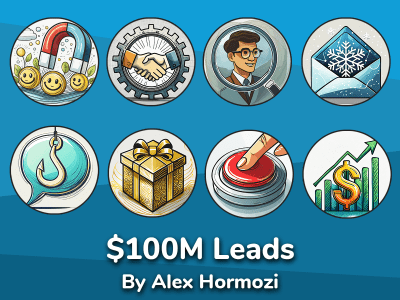





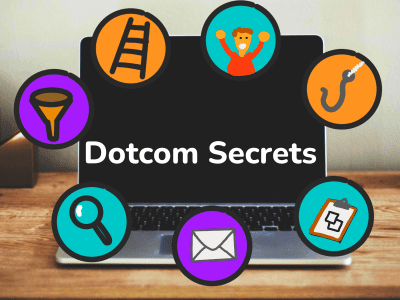
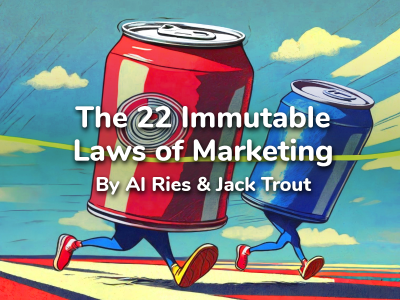
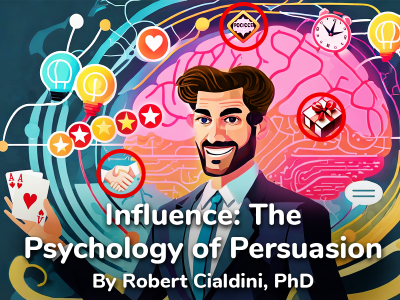







Community Notes